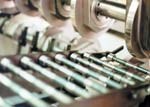Straightening Solutions For High Volume Production
Maintaining straightness of shaftlike parts during production presents a difficult challenge for screw machine houses and coldforming shops.
Maintaining straightness of shaftlike parts during production presents a difficult challenge for screw machine houses and cold-forming shops. During various machining processes, it's inevitable that some parts will bend or warp. Metal deformation can result when internal stresses are added, disturbed or unevenly released. In addition to machiningrelated causes, this can occur during forming, knurling, thread rolling or heat-treatment processes.
Although perfect straightness exists only in theory, part variations can be reduced to fall within acceptable limits. As the length of a part increases, straightness flaws become more pronounced. If straightness cannot be controlled during the normal manufacturing process, a separate finishing operation may be required prior to grinding or threading.
Traditionally, after inspection, shops have straightened outoftolerance parts on arbor presses, or perhaps discarded them. Corrective straightening, however, is still a trialanderror method for many shops. Furthermore, many straightening machines are only suitable for use in relatively low volume production operations. Because of time lost sorting and straightening on a piecemeal basis, high volume shops often prefer to avoid straightening operations entirely. Thus, manufacturers frequently conclude that the cost of producing new parts is less than straightening existing parts.
To eliminate this cycle of wasted time and materials, Benex Corporation (Rochester, New York) has developed a new, centerless straightening machine. This machine was originally developed for the precisionshaft industry, but it's currently finding applications in screw machine and cold-forming shops. The machine accepts shaftlike parts as large as ½ inch diameter (heat-treated) or 5/8 inch diameter (soft) with maximum lengths of 48 inches. It uses two sets of vertically opposed, eccentric rollers to straighten shaftlike parts at a rate of 1,200 cycles per hour.
A standard, magazinetype feed system transports parts automatically through the straightening cycle and ejects them onto an exit ramp. When parts are shorter than 48 inches, the machine can also be equipped to feed up to four parts simultaneously (side by side). This expands the machine's capacity to a maximum of 4,800 parts per hour.
The machine eliminates the need for sorting because it can process entire lots efficiently, including parts that need straightened, as well as those that do not. A user-friendly design enables frequent and quick changeovers. The machine is also capable of simultaneously knurling parts during the straightening process with no reduction in cycle time. Its design is mechanically simple and reliable, with no hydraulics, computer controls or other "bells and whistles." Operation is surprisingly quiet, and the machine's total weight is less than 3,000 lbs.


















